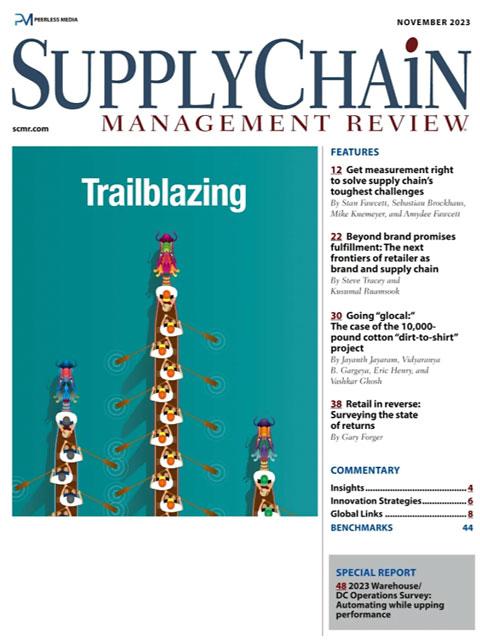Sorry, but your login has failed. Please recheck your login information and resubmit. If your subscription has expired, renew here.
November 2023
Last month, I had the pleasure of attending the NextGen Supply Chain Awards in Chicago. It was my first time attending the conference, which was in its fifth year, and I came away impressed with both the content and the quality of professionals I met in Chicago. This year’s conference—Strategies for a Digital Future—featured nearly 50 speakers and included CEOs and senior vice presidents, founders and innovators, leading academics and researchers, and top consultants. Over two days of the event at the Chicago Athletic Association, we learned more about artificial intelligence and predictive analytics, robotics and machine learning, fulfillment… Browse this issue archive.Need Help? Contact customer service 847-559-7581 More options
Organizations operating in today’s rapidly evolving and interconnected global economy face an array of challenges that can disrupt the seamless flow of goods and services within their supply chains. From natural disasters to geopolitical uncertainties, the need to establish resilient supply chains capable of withstanding and swiftly recovering from disruptions has become a strategic imperative.
Companies face significant challenges to enable supply chain resilience
There is a wide range of challenges and risks that can impact an organization’s ability to respond with resilience to disruption. These include operational risks such as equipment failure or labor shortages, financial risks such as currency fluctuations or credit risks, and legal risks such as compliance with regulations and laws.
Building supply chain resilience involves identifying these potential risks and, more importantly, the specific vulnerabilities to implementing measures to mitigate them. Having contingency plans in place to respond to disruptions when they occur is critical. From the top floor to the operating floor, having the necessary strategies, systems, and resources in place to quickly respond to and recover from disruptions is a competitive if not
existential mandate.
Often overlooked is the role procurement plays. Its emergence as a critical driver in building and fortifying organizations against potential vulnerabilities must be a cornerstone for resilience
initiatives and risk mitigation.
The role of procurement (and sourcing) in business continuity and resilience

This complete article is available to subscribers only.
Log in now for full access or start your PLUS+ subscription for instant access.
SC
MR
Sorry, but your login has failed. Please recheck your login information and resubmit. If your subscription has expired, renew here.
November 2023
Last month, I had the pleasure of attending the NextGen Supply Chain Awards in Chicago. It was my first time attending the conference, which was in its fifth year, and I came away impressed with both the content and… Browse this issue archive. Access your online digital edition. Download a PDF file of the November 2023 issue.Organizations operating in today’s rapidly evolving and interconnected global economy face an array of challenges that can disrupt the seamless flow of goods and services within their supply chains. From natural disasters to geopolitical uncertainties, the need to establish resilient supply chains capable of withstanding and swiftly recovering from disruptions has become a strategic imperative.
Companies face significant challenges to enable supply chain resilience
There is a wide range of challenges and risks that can impact an organization’s ability to respond with resilience to disruption. These include operational risks such as equipment failure or labor shortages, financial risks such as currency fluctuations or credit risks, and legal risks such as compliance with regulations and laws.
Building supply chain resilience involves identifying these potential risks and, more importantly, the specific vulnerabilities to implementing measures to mitigate them. Having contingency plans in place to respond to disruptions when they occur is critical. From the top floor to the operating floor, having the necessary strategies, systems, and resources in place to quickly respond to and recover from disruptions is a competitive if not
existential mandate.
Often overlooked is the role procurement plays. Its emergence as a critical driver in building and fortifying organizations against potential vulnerabilities must be a cornerstone for resilience
initiatives and risk mitigation.
The role of procurement (and sourcing) in business continuity and resilience
 SUBSCRIBERS: Click here to download PDF of the full article.
SUBSCRIBERS: Click here to download PDF of the full article.
SC
MR


More 3PL
- Services sector sees growth in October, reports ISM
- Managing inbound freight: What has changed in two decades?
- Inbound freight: Often a missed opportunity
- 2024 Warehouse/DC Operations Survey: Technology adoption on the rise
- Looking back at NextGen 2024
- Manufacturing again contracts in October, reports ISM
- More 3PL
Latest Podcast

 Explore
Explore
Topics
Procurement & Sourcing News
- Strengthening customer fulfillment: Building a strategic stakeholder network
- Trump picks former Wisconsin congressman Sean Duffy for DOT secretary
- Made in Mexico, manufactured by China
- Retail sales see gains in October, reports Commerce and NRF
- Geopolitical readiness in supply chains: Strategic challenges for leaders
- With capacity to spare, logistics real estate demand remains subdued
- More Procurement & Sourcing
Latest Procurement & Sourcing Resources

Subscribe

Supply Chain Management Review delivers the best industry content.

Editors’ Picks





